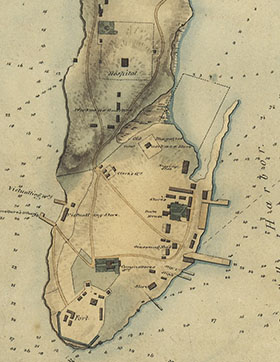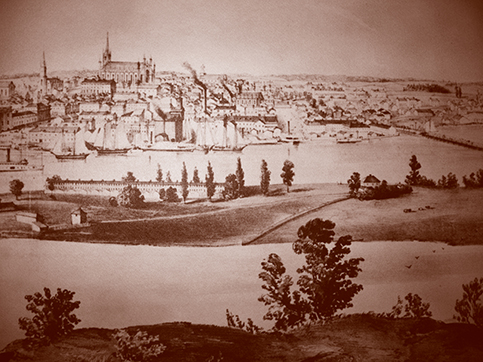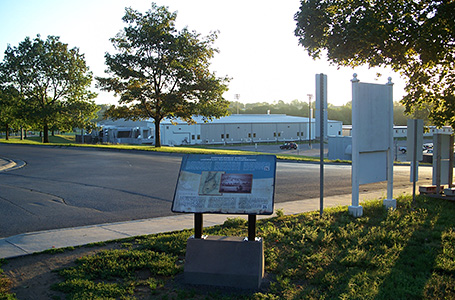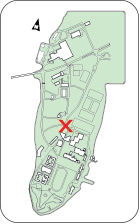While a debatable strategy, by mid-1813, both the British and American Commodores concluded that, given the near parity of naval power then existing, they must not attempt decisive action against each other for fear of defeat and hence loss of the war. This resulted in a ship-building competition between the Royal Navy Dockyard and the United States facility at Sackets Harbor on the south shore of Lake Ontario. The workforce here expanded rapidly reaching over 130 professional shipwrights and other artificers supported by a daily labour force of over 1,200. This influx created a critical accommodation problem as Kingston could not house this number given the equally rapid growth of the town and garrison.
 Extract of a contemporary sketch map of the shores and measures in the vicinity of Kingston from a survey by Lieutenant H.L. Renny, RE, and soundings by Acting Lieutenant W. Bayfield, RN. Fortifications and buildings on Point Frederick are illustrated.
Extract of a contemporary sketch map of the shores and measures in the vicinity of Kingston from a survey by Lieutenant H.L. Renny, RE, and soundings by Acting Lieutenant W. Bayfield, RN. Fortifications and buildings on Point Frederick are illustrated.
 Contemporary sketch drawing from Point Henry showing the artisans' row cottages on Point Frederick with the town of Kingston in the background.
Contemporary sketch drawing from Point Henry showing the artisans' row cottages on Point Frederick with the town of Kingston in the background.
As the work continued, some artificers built small, single-room row cottages along the shoreline of the Cataraqui River, facing the town. Opposite, on the shore of Navy Bay, wooden 'shanties' housing the day workers and others sprang up, and all of these were outside of the Dockyard fence which had been erected partly to prevent the shanties spreading further onto the Point. Beyond the shanties was the 'Mast Pond', stretching into Navy Bay, where the wood for masts was immersed for seasoning.
Walking Tour

 Panel 10 is located at the end of Watt's Walk (a gift of the Class of 1983) on General Crerar Drive at the southern end of Precision Drive. It looks out over the sports fields which cover much of what used to be Navy Bay.
Panel 10 is located at the end of Watt's Walk (a gift of the Class of 1983) on General Crerar Drive at the southern end of Precision Drive. It looks out over the sports fields which cover much of what used to be Navy Bay.